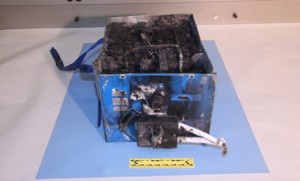
NTSB photo of the burned auxiliary power unit battery from a JAL Boeing 787 that caught fire on Jan. 7 at Boston’s Logan International Airport.
The lithium-ion battery that powered the auxiliary power unit on the airplane was removed and transported back to the NTSB Materials Laboratory in Washington on Jan. 10. The battery is currently being examined by NTSB investigators, who plan to disassemble it this week.
In advance of that work, under the direction of the NTSB, radiographic examinations of the incident battery and an exemplar battery were conducted this past weekend at an independent test facility. The digital radiographs and computed tomography scans generated from this examination allowed the team to document the internal condition of the battery prior to disassembling it.
In addition, investigators took possession of burned wire bundles, the APU battery charger, and several memory modules. The maintenance and APU controller memory modules will be downloaded to obtain any available data. Investigators also documented the entire aft electronics bay including the APU battery and the nearby affected structure where components and wire bundles were located.
The airplane’s two combined flight data recorder and cockpit voice recorder units were transported to NTSB headquarters and have been successfully downloaded. The information is currently being analyzed by the investigative team.
The airport emergency response group documented the airport rescue and firefighting efforts to extinguish the fire, which included interviews with first responders. Fire and rescue personnel were able to contain the fire using a clean agent (Halotron), however, they reported experiencing difficulty accessing the battery for removal during extinguishing efforts. All fire and rescue personnel responding to the incident had previously received aircraft familiarization training on the Boeing 787.
In accordance with international investigative treaties, the Japan Transport Safety Board and French Bureau d’Enquêtes et d’Analyses pour la sécurité de l’aviation civile have appointed accredited representatives to the investigation. The NTSB-led investigative team is comprised of subject matter groups in the areas of airplane systems, fire, airport emergency response, and data recorders and includes experts from the Federal Aviation Administration, The Boeing Company, US Naval Surface Warfare Center’s Carderock Division, Japan Airlines (aircraft operator), GS Yuasa (battery manufacturer), and Thales Avionics Electrical Systems (APU battery/charger system).


